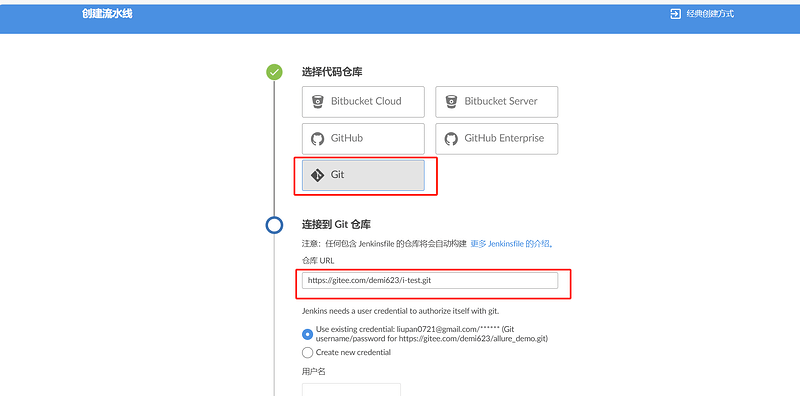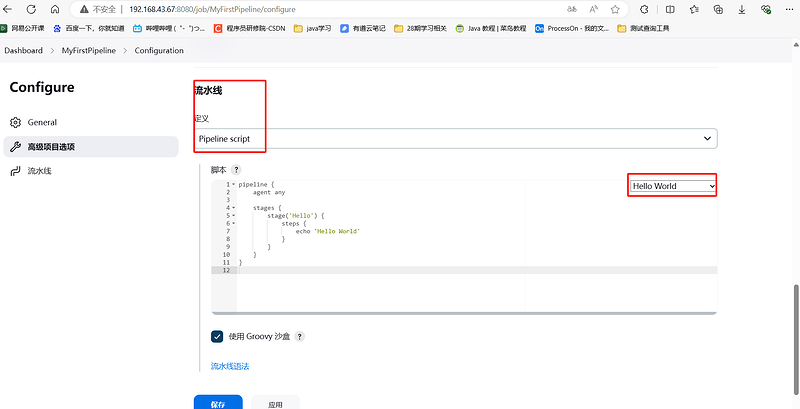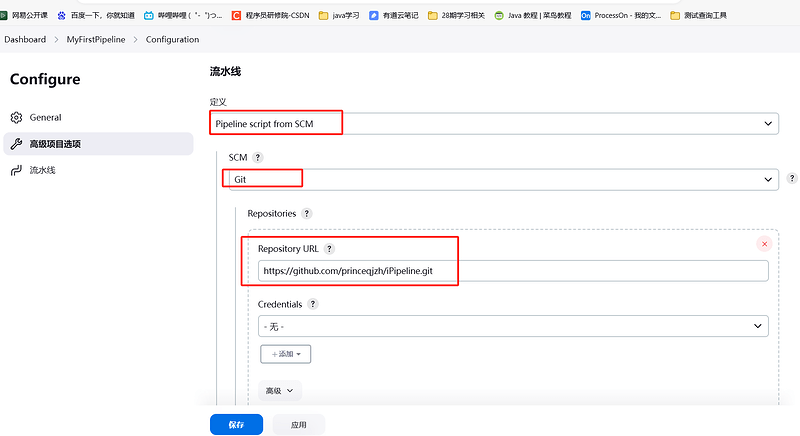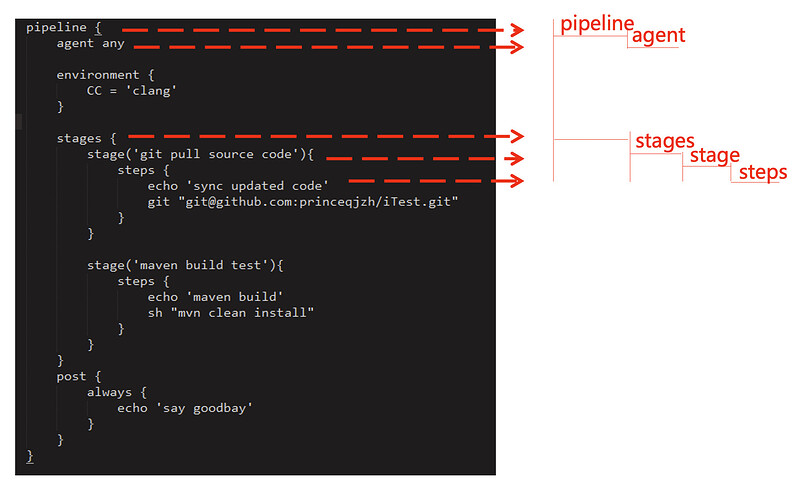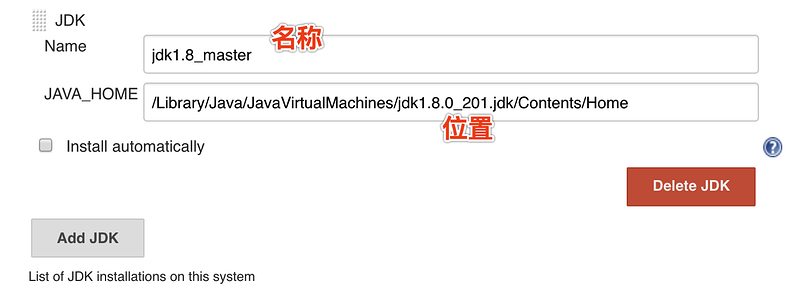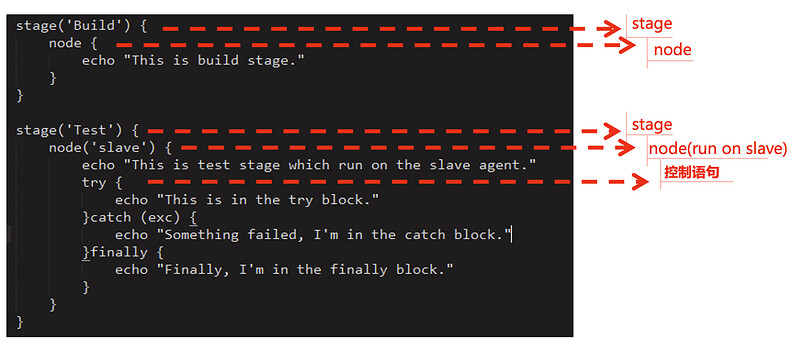一, BlueOcean介绍
1.1 BlueOcean简介
- 提供了一套可视化操作界面来帮助创建、编辑 Pipeline 任务
- 它为开发人员提供了更具乐趣的Jenkins使用方式
- 实现了一种全新的、现代风格的用户界面
- 有助于任何规模的团队实现持续交付
1.2 BlueOcean特性
- 流水线编辑器:是一种直观并可视化的流水线编辑器
- 流水线的可视化:对流水线的可视化表示
- 流水线的诊断:即刻定位任务问题
- 个性化仪表盘:用户可以自定义仪表盘,只显示与自身相关的流水线
1.3 BlueOcean 安装
- 需要在 Jenkins plugin 中安装 BlueOcean插件
1.4 Blue Ocean 创建Pipeline
-
打开 Blue Ocean
-
创建Pipeline(流水线)
-
在创建的流水线编辑Pipeline,该种方式需要为每个步骤单独写入流水线Jenkinsfile语法
-
通过远程代码Jenkinsfile文件来编辑多分支流水线
- 创建流水线后进入该流水线,点击进入jenkins流水线任务
- 在构建配置 - 脚本路径加上项目名称
- 扫描多分支流水线
- 创建流水线后进入该流水线,点击进入jenkins流水线任务
二, Pipeline
2.1 简介
- 借用Unix 中的Pipeline思路,一种高内聚低耦合的工具
- Jenkins 2.0 以上才会有
- 一系列 Jenkins 插件将整个持续集成用解释性代码 Jenkinsfile 来描述
- Jenkinsfile 使用方法:
- Jenkins 任务页面输入
- 源代码工程中编辑
- Jenkinsfile 语法类型:
- Declarative pipeline
- Scripts pipeline
2.2 创建Pipeline任务
-
新建Pipeline任务
-
流水线选择 Pipeline Script,选择模块添加Pipeline代码
-
利用Git源码库导入 Jenkins Pipeline
- Pipeline 的代码也可以放入 git 源码库进行管理
- 在Jenkins Pipeline 任务中选择 Pipeline script from SCM,然后添加 git 源码地址, 在Script Path中填写需要运行的Jenkinsfile文件所在的地址
- 例子源码位置: https://github.com/princeqjzh/iPipeline
三, Jenkinsfile 语法
3.1 Jenkinsfile 简介
- Jenkinsfile 支持两种语法形式 :
- Declarative pipeline - v2.5之后引入,结构化方式
- Scripts pipeline - 基于 groovy 的语法
3.2 Jenkinsfile 语法参数 agent,stage,step
(1) Declarative 语句树
(2) Declarative Pipeline - agent
-
agent :定义pipeline执行节点
- 必须出现的指令
- 参数
- any:可以在任意agent上执行pipeline
- none:pipeline将不分配全局agent, 每个stage分配自己的agent
- label:指定运行节点的Label
- node:自定义运行节点配置,
- 指定 label
- 指定 customWorkspace
- docker:控制目标节点上的docker运行相关内容
-
举例说明:
pipeline {
agent {
label 'master'
customWorkspace 'myWorkspace'
}
}
(3) Declarative Pipeline - stages
- stages:
- 必须出现的指令
- 无参数
- 包含一个或多个stage的序列,Pipeline的大部分工作在此执行;
- 每个Pipeline 代码区间中必须只有一个stages
(4) Declarative Pipeline - stage
- stage:
- 必须出现的指令
- 无参数
- 包含在stages中
- Pipeline完成的所有实际工作都需要包含到stage中
- 需要定义stage的名字
(5) Declarative Pipeline - steps
-
steps:
- 必须出现的指令
- 无参数
- 具体执行步骤,包含在 stage 代码区间中
-
代码举例
pipeline {
agent {
node {
label 'master'
customWorkspace 'pipelineWorkspace'
}
}
stages {
stage('begin') {
parallel {
stage('begin') {
steps {
echo 'hello pipeline begin'
}
}
stage('Parallel Steps') {
steps {
sh 'echo "Begin Step"'
}
}
}
}
stage('running') {
parallel {
stage('running') {
steps {
echo 'hello pipeline running'
}
}
stage('running 2') {
steps {
sh 'echo "This is running 2"'
}
}
}
}
stage('finish') {
steps {
echo 'hello pipeline finish'
sh 'exit 0'
}
}
}
post {
success {
echo 'goodbye pipeline success!'
}
failure {
echo 'ops!!! pipeline failed....'
}
always {
echo 'always say goodbye'
}
}
}
3.3 Jenkinsfile 语法参数 post
-
post :定义Pipeline或stage运行结束时的操作
- 不是必须出现的指令
- 参数:
- always:无论Pipeline运行的完成状态如何都会运行
- changed:只有当前Pipeline运行的状态与先前完成的Pipeline的状态不同时,才能运行
- failure:仅当当前Pipeline处于“失败”状态时才运行
- success :仅当当前Pipeline具有“成功”状态时才运行
- unstable:只有当前Pipeline具有“不稳定”状态才能运行
- aborted:只有当前Pipeline处于“中止”状态时才能运行
-
post代码举例
pipeline {
agent any
stages {
stage('Test') {
steps {
echo 'This is test code'
sleep 2
sh 'exit 0'
}
}
}
post{
always {
echo 'always say goodbye'
}
success {
echo 'This is success exit'
}
failure {
echo 'This is failure exit'
}
}
}
3.3 Jenkinsfile 语法参数 options
-
options :定义pipeline 的专有属性
- 不是必须出现的指令
- 参数:
- 不是必须出现的指令
- buildDiscarder:保持构建的最大个数
- disableConcurrentBuilds:不允许并行执行pipeline任务
- timeout:pipeline 超时时间
- retry:失败后,重试整个Pipeline的次数
- timestamps:预定义由Pipeline生成的所有控制台输出时间
- skipStagesAfterUnstable:一旦构建状态进入了“Unstable”状态,就跳过此stage
-
代码举例
pipeline {
agent {
node{
label 'slaveNode'
customWorkspace "pipelineWorkspace"
}
}
options {
timeout(time: 30, unit: 'SECONDS')
buildDiscarder(logRotator(numToKeepStr: '2'))
retry(5)
}
stages {
stage('begin'){
steps {
echo 'hello pipeline begin'
sleep 2
}
}
stage('running'){
steps {
echo 'hello pipeline running'
sleep 2
}
}
stage('finish'){
steps {
echo 'hello pipeline finish'
sleep 2
sh 'exit 0'
}
}
}
post {
success {
echo 'goodbye pipeline success!'
sleep 2
}
failure {
echo 'ops!!! pipeline failed....'
sleep 2
}
always {
echo 'always say goodbye'
}
}
}
3.4 Jenkinsfile 语法参数 parameters
-
parameters :定义pipeline 的专有参数列表
- 不是必须出现的指令
- 参数:
- 支持数据类型:booleanParam, choice, credentials, file, text, password, run, string
- 类似参数化构建的选项
- 新建pipeline job时,需要同时配置参数化选项
- 新建pipeline job时,需要同时配置参数化选项
-
代码举例
pipeline {
agent {
node{
label 'slaveNode'
customWorkspace "myWorkspace"
}
}
parameters {
string(name: 'PERSON', defaultValue: 'Jenkins', description: '输入的文本参数')
}
stages {
stage('Test Parameters'){
steps {
echo "Hello ${params.PERSON}"
}
}
}
}
3.5 Jenkinsfile 语法参数 env_tools
-
环境工具变量的定义
-
设置位置: “Manage Jenkins”-> “Global Tool Configuration”
- 定义java_home
- 定义maven_home
- 定义java_home
-
Script 代码中引用环境变量,调用java、maven工具
stage('env tools') {
node('master'){
//定义maven java环境
def mvnHome = tool 'maven-3.6.0_master'
def jdkHome = tool 'jdk1.8_master'
//引用环境变量,配置PATH变量
env.PATH = "${mvnHome}/bin:${env.PATH}"
env.PATH = "${jdkHome}/bin:${env.PATH}"
//调用java mvn 工具
sh "java -version"
sh "mvn --version"
}
}
3.6 Jenkinsfile 语法参数 if-else &try-catch
(1) Scripts pipeline介绍
-
基于 groovy 语法定制的一种DSL语言
-
灵活性更高
-
可扩展性更好
-
Script pipeline 与 Declarative pipeline 程序构成方式有雷同之处,基本语句也有相似之处
-
Script pipeline 语句树
(2) Scripts pipeline: 流程控制之 – if/else
node {
stage('Example') {
if (env.BRANCH_NAME == 'master') {
echo 'I only execute on the master branch'
} else {
echo 'I execute elsewhere'
}
}
}
stage('Build') {
node {
echo "This is build stage."
}
}
* BRANCH_NAME为定义的变量参数,在键job时要选择参数化新增该参数
(3) Scripts pipeline: 流程控制 try-catch
stage('prepare') {
node {
echo "This is prepare stage."
}
}
stage('Test') {
node{
echo "This is test stage which run on the slave agent."
try {
echo "This is in the try block."
}catch (exc) {
echo "Something failed, I'm in the catch block."
}finally {
echo "Finally, I'm in the finally block."
}
}
}
3.7 Jenkinsfile 语法参数 environment
-
environment: 定义Pipeline或stage运行时的环境变量
-
不是必须出现的指令
-
无参数
-
代码示例
pipeline {
agent {
node{
label 'slave'
customWorkspace "myWorkspace"
}
}
environment {
hlw = 'hello world'
}
stages {
stage('Print environment_1'){
steps {
echo hlw
sleep 5
}
}
stage('Print environment_2'){
steps {
sh 'echo ${hlw}'
sleep 5
}
}
}
post {
success {
echo 'goodbye pipeline success!'
}
failure {
echo 'ops!!! pipeline failed....'
sleep 5
}
always {
echo 'always say goodbye'
}
}
}
3.8 Jenkinsfile 语法参数triggers
-
triggers:定义了Pipeline自动化触发的方式
- 不是必须出现的指令
- 参数:
- cron:接受一个cron风格的字符串来定义Pipeline触发的常规间隔
- pollSCM:接受一个cron风格的字符串来定义 Jenkins 检查SCM源更改的常规间隔;如果存在新的更改,则Pipeline将被重新触发。
-
代码示例
pipeline {
agent {
node{
label 'slaveNode'
customWorkspace "myWorkspace"
}
}
triggers {
cron('H/2 * * * *')
}
stages {
stage('Test Parameters'){
steps {
echo "Hello world"
}
}
}
}


